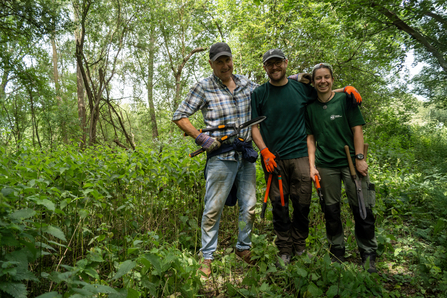In the East of the county, our volunteers have been helping with a range of tasks from hedgelaying and deer fencing to reedbed management and invasive species removal. Over at Hill Park, volunteers helped lay a whopping 95 meters of hedge, creating important wildlife corridors and habitat for a diverse array of plant and animal species. Dead hedge-style deer fencing has been created at Graeme Hendry Wood and Vann Lake to protect new tree shoots in recently coppiced coupes. Volunteers also helped with reedbed management at Hedgecourt Lake, clearing recently cut reeds with naval assistance from Crawley Mariners Yacht Club.
With special dispensation from Natural England alongside caution and awareness of ground nesting birds, our volunteers have also assisted with tree popping at Coneyboro Hill and Fames Rough. This site is part of the Chipstead Downs Site of Special Scientific Interest and is a haven for many rare plant species, with scrub clearance being an important aspect of its conservation management. Most recently, our East volunteers have been knee-deep in Himalayan balsam removal at Newdigate Brickworks, Vann Lake and Hedgecourt; controlling this invasive species is crucial to maintain biodiversity and protect our native plant species which otherwise get outcompeted.
At the opposite end of the county in the West, our volunteers have been making sure our reserves are ready for our Belted Galloways. Introducing conservation grazing livestock is an important aspect of heathland management, preventing scrub and bracken from dominating the landscape, making way for heather and other important plant species to thrive. Our volunteers have been helping with fence checks and maintenance as well as preparing NoFence compartments ready for the cattle to moo-ve in. They have also been hard at work removing invasive species including piri-piri, Himalayan balsam and bracken at sites including Whitmoor Common, Wisley Common, Royal Common and Gracious Pond. During a recent session at Royal Common our volunteers filled two large drag bags with piri-piri which is a huge testament to their efforts as it is very fiddly to remove and requires a lot of patience and determination!


